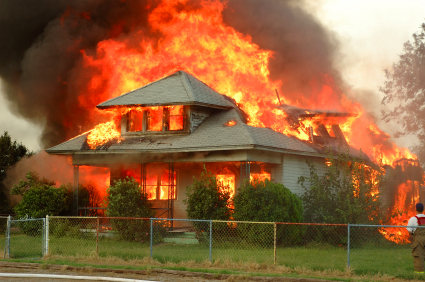The first step in an emergency exit plan is to know where all of the exits are. You should have two exits in each bedroom. In many cases this means a door and a window. It’s important that all members of your family are able to find all exits without any hesitation or assistance. During a fire there may be a lot of thick smoke that makes it difficult to see clearly. You should be able to reach all exits with your eyes closed.
 If your bedrooms are located on the second floor of your home, window escape routes will be more difficult to use as a part of your emergency exit plan. However, in the case of a fire, it may be necessary to do so. Every member of the family should know how to exit from a second storey window. Placing a ladder on the outside of your home to make escape easier is NOT recommended. Criminals frequently use such ladders to gain entrance to a home.
If your bedrooms are located on the second floor of your home, window escape routes will be more difficult to use as a part of your emergency exit plan. However, in the case of a fire, it may be necessary to do so. Every member of the family should know how to exit from a second storey window. Placing a ladder on the outside of your home to make escape easier is NOT recommended. Criminals frequently use such ladders to gain entrance to a home.Emergency Exit Plan Details to Keep in Mind
 If you have security bars on your windows, it’s important that they are easy to remove from the inside. In the case of an emergency you may not be able to find a key in time and quickly exiting through the window may be your only chance to escape. For this reason, you should periodically check that your windows can open freely and are not jammed. This is vital for a successful emergency exit plan.
If you have security bars on your windows, it’s important that they are easy to remove from the inside. In the case of an emergency you may not be able to find a key in time and quickly exiting through the window may be your only chance to escape. For this reason, you should periodically check that your windows can open freely and are not jammed. This is vital for a successful emergency exit plan. It’s important that every member of your family understands the emergency exit plan and that you practice the plan from time-to-time. If you live with children, elderly people or anyone else that may require assistance, be aware that you will likely need to provide help to these people during an emergency.
One of the best ways to ensure minimal damage and a safe escape in the event of a fire is to have smoke detectors, carbon monoxide detectors and fire alarms. These should be placed on every floor and regularly tested. You can even have your alarms monitored from a central alarm monitoring station to provide protection 24/7, even if you’re not at home. Doing so will improve your safety and help with your emergency exit plan.
